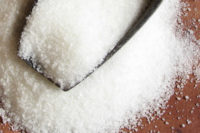The USDA recently released new 2020-2025 Dietary Guidelines for Americans. For the candy industry, the parts that stand out relate to added sugars.
The most notable change relates to children under 2 years old, who were given specific guidelines in the report for the first time. The USDA is recommending zero added sugars for that age group.
The agency said infants and young children have virtually no room in their diet for added sugars because they have such high nutrient requirements relative to their size.
Taking that one step further, the USDA also recommends that children under 2 years old should not have sugar substituted for low- or no-calorie sweeteners.
“Taste preferences are being formed during this time period, and infants and young children may develop preferences for overly sweet foods if introduced to very sweet foods during this timeframe,” the USDA says.
In short, this age group should basically not eat any candy.
Most confectioners haven’t been marketing their products to that age group anyway, but as the USDA said, this is when tastes are being formed. If little kids don’t eat candy, they are less likely to eat sweets as they get older.
After age 2, the USDA says that less than 10 percent of calories per day should be from added sugars.
That guideline is the same as it was in the 2015-2020 report, despite the fact that a scientific advisory committee had recommended that they be cut down to 6 percent of daily calories, as the New York Times explains.
However, again, the USDA says to be cautious about replacing them with low and no-calorie sweeteners, as questions remain about their effectiveness as a long-term weight management strategy.
The good news for the confectionery industry is that candy is relatively low on the list of food and beverages from which Americans get their added sugar.
Specifically, the USDA says that the top sources include:
- 24 percent is sugar-sweetened beverages, the top source
- 19 percent desserts and sweet snacks
- 11 percent coffee and tea
- 7 percent breakfast cereals and bars
- 7 percent sandwiches
- 9 percent candy and sugar
- 4 percent higher fat milk and yogurt
There’s something to be said for how realistic all these guidelines are, and many Americans may just ignore them. But they do shape things at a larger level, including product development, school lunch menus, and how doctors talk to their patients about healthy eating.
So, in that sense, they are important to be aware of.
For it’s part, though, the candy industry has long been aware of the need to limit added sugar. The National Confectioners Association’s Always a Treat initiative encourages moderation.
It’s a great program, and the candy industry deserves credit for addressing an issue that might seem easier to ignore.
Seeing guidance from the UDSA that cautions against swapping out sugar for low- or no-calorie sweeteners, though, highlights how difficult added sugar will be to deal with.
And while the USDA ignored the scientific community’s recommendation to lower the amount of added sugar to 6 percent of daily calories this time, it seems likely that they’ll change it eventually — whether it’s in 2025, 2030 or beyond.
Confectionery companies would be wise to start accepting this now, so they can be ahead of the curve if it’s changed later.
We are all living in tumultuous times, and the last year has only served to highlight how important candy can be for emotional well-being. After all, chocolate was the top quarantine snack food.
There’s no reason we can’t enjoy a piece of chocolate every day, as long as we only don’t eat the whole bag. It’s rarity that makes candy feel so indulgent anyway.





